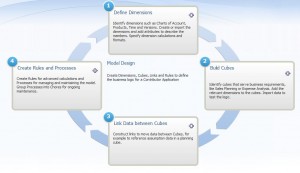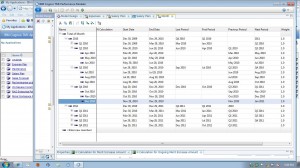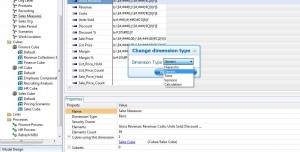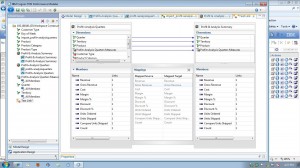The New Face of TM1: Performance Modeler
On February 7, 2012, IBM Cognos released the newest version of TM1: TM1 10.1. TM1 has been around for a very long time but has really only recently come to be recognized as the premier planning tool for any size business.
Its only criticism was that unlike its sibling Enterprise Planning (EP) it was not an “out of the box” solution that the finance department could run independent of its own IT department. In fact, it gave rise to a somewhat symbiotic relationship between IT and Finance because of the scripting involved in applying rules to a cube and importing data through a Turbo Integrator or manually coded process. That said, I believe all this has changed with this release (10.1) of TM1.
TM1 – Performance Modeler
TM1 now contains a “partner” to Architect, called Performance Modeler and if you come from the EP world as I did, when you first open and begin to play around it feels more like EP than it does TM1. The first screen of the application provides you an outline on the steps to designing a new TM1 model. Let’s examine each of these four critical areas one at a time.
Model Design Flowchart
1) Define Dimensions: While the functionality behind this step is obvious, one of the most intriguing aspects of this application is that TM1 now recognizes time dimensions and treats them accordingly. Calculations are now being entered at the dimension level, therefor designating a time dimension at its creation becomes critical for several reasons:
– The new TM-1 10.1 logic that automates the cube rule generation.
– It allows for simple leaf level calculations or more complex C-level calculations, such as weighted or time averages within the Measures or Time dimension, e.g. Year over Year comparisons.
– A wide array of attributes/properties can be automatically populated as part of the dimension creation, including Start Date, End Date, First Period, Last Period and so on.
Dimension with Start Date, End Date, First Period, Last Period etc.
2) Build Cubes: The building of cubes from the dimensions you created is not really any different than any other version of TM1. However, there is a new feature called Guided Import, which facilitates data population by mapping. The Guided Import function will auto-generate a TI process in the background complete with all the scripting needed in the Advanced tabs (Prologue, Metadata, Data and Epilogue) to build a Dimension or cube or populate it with data. The TI process can then be saved for updating a cube/dimension on a regular basis.
Another improvement is the ability to now add dimensions to a cube “on the fly”. Iterative development was not something that was warmly received by the TM-1 software. If you were developing a cube where the initial model was designed and the requirements changed with the need to add a new dimension to one or more of the cubes, you basically had to start over rebuilding those cubes. Not any longer, now you simply add the dimension to the cube and tell the application where the data should reside. The dimension is added and placed in the proper order according to the dimension type you have chosen.
Selection of Dimension Type
3) Link Data between Cubes: In this part of the model design process you construct “links” to move data between the cubes you have built. For example, if the need arose to map assumption data from a currency cube with a static data cube. In the background the new TM1 software is building a rules file complete with DB statements that will go out to the database and retrieve the required data and load it to the target cube. It is also important to note that this is where the use of ‘pick-lists” or “virtual dimensions” (as they are referred to in EP) as well as attributes come into play. They are used to create data driven links and determine what type of link (look-up or accumulation) you will build to move the data. In a Look-up Link, the target cube has information on one or more pick lists on a dimension. This makes it possible to take data from the source or “look-up” cube and use it in a multitude of cells in the target cube. Conversely in an accumulation link, the source cube has information on one or more pick lists on a dimension. This makes it possible to accumulate data from several cells in the source cube and populate it to a single cell in the target cube. The software will automatically map identical dimensions for you or you can choose to manually map source and target dimensions. The one caveat here is that if you choose manual mapping you will lose the dynamic nature of automatic mapping and every time an item is added you will have to go in and maintain that link.
Linking Capability
4) Create Rules and Processes: In this final area, you will apply advanced business logic and processes to the cubes you have constructed at the dimension level. With the new engine, you don’t need to recreate complex EP BiF scripting in TM1 because the software will now do it for you along with many other complex calculations. In addition, the new application will now script feeders for you, whether it is pulling data from another cube or applying a complex depreciation formula to a measure to name a few. If you have any exposure to TM1 you know what a quantum leap this new feature represents
Auto Generated Link Feeder Rule
The GUID number(7D4C696E6B5F…)is how the software logic associates the data much like in EP.
Conclusion
There are many more new and exciting features that have been introduced in this release of TM1 and Performance Modeler but there are two caveats that we noticed during implementation: first; the software has a tendency to overfeed certain calculations and second, in some cases we have witnessed the auto-generated rules were not scripted in the correct order to produce the desired calculation. All in all however, I am very impressed with how far TM1 has come in such a short time. It has all the power, speed and scalability of TM1 with all the ease of use “out of the box” solution capability for the finance department to again work independently of IT.







